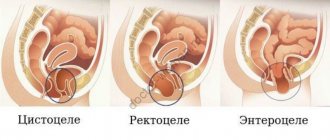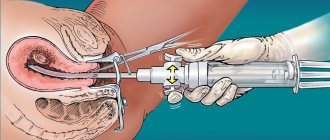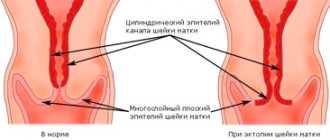Cervical erosion is one of the most common gynecological diseases, which almost every 5th woman encounters during her life, and sometimes more than once. However, erosion cannot be called a harmless condition. Although it is almost asymptomatic and can persist for years, over time, pathological changes in the mucous membrane of the cervix progress and ultimately can develop into cancer, which annually claims tens of thousands of women's lives. Therefore, it is important at least once a year, and preferably every six months, to make an appointment with a gynecologist, and if cervical erosion is detected, immediately undergo examination and begin treatment.
Doctor's comment: Almost every woman in her life has heard about such a disease as cervical erosion; many were diagnosed with this and treated, but, unfortunately, not all patients managed to solve this problem. The question arises: “Why?..”
What is erosion
The content of the article
Pathology is a defect in the mucous membrane, which can occur against the background of infections, injuries or hormonal disorders and have varying severity, which will determine the method of treatment.
There are true erosion, pseudo-erosion and ectropion. With all these pathologies, a bright red area of damaged or modified epithelium appears on the cervix around its pharynx - this is what the upper layer of cells is called in medicine.
This disease affects women of any age. Most cases occur during the reproductive period and later; about 12% of patients are teenage girls. Gynecologists state that during routine examinations one of the types of erosion is detected in every second patient.
Consequences of cauterization
If cauterization was carried out justifiably, in the presence of strict indications, the procedure itself was carried out by a qualified specialist, the consequences will be minimal. Undesirable effects may occur after treatment:
- Pain in the chest and lower abdomen - this condition occurs for 2-3 days and is considered normal. If the pain does not go away within 1 week, you should consult a specialist.
- Relapse, when erosion occurs again after cauterization. Repeated cell damage occurs for the same reasons that ectopia initially appeared - HPV carriage, regular cervical injury, hormonal imbalance. But most often, erosion recurs during pregnancy due to hormonal changes in the body. In this case, the disease may go away on its own after delivery.
- Scar on the cervix. This phenomenon practically does not occur after treating erosion with radio waves or a laser; with other types of cauterization it occurs as an undesirable effect. Scars and deformations subsequently lead to problems with conception and miscarriage.
- Discharge. A dangerous side effect is bleeding - it sometimes occurs immediately after the procedure and lasts for several days, rarely even requiring hospitalization of the patient. The main cause of bleeding is damage to healthy tissue. Scanty discharge with blood disappears 10 days after the procedure. Such leucorrhoea has a liquid consistency and is odorless and does not cause discomfort.
Depending on the results of cauterization and the choice of procedure method, a woman rarely experiences individual side effects, for example, intolerance to the components for chemical cauterization, increased pain, and menstrual disorders.
Types and causes of erosion formation
This group of diseases combines several different processes, but they all relate to changes in the upper layers of the cervix.
- True erosion.
Appears as a result of mechanical damage to the cervix during unsuccessful medical procedures or due to erosion of the mucous membrane by pathological secretions - they often have high acidity. The eroded area visually represents a wound with a bleeding surface. - Pseudo-erosion (ectopia)
. With pseudo-erosion, the squamous cervical epithelium (the normal shape of the covering cells) is replaced by a cylindrical one. Cylindrical cells do not perform a protective function, therefore they are foreign and dangerous to the organ. Without treatment, pathological cells grow and penetrate deep into healthy tissues. - Ectropion
. This is the internal portion of the cervix that protrudes outward (outside the cervical canal). Formed when tissue is damaged or may be a congenital pathology. In this case, everything happens the other way around: the inner layer of cylindrical cells, appearing on top, enters the vaginal environment, which is unusual for it (for example, when the cervix is dissected), is destroyed, replaced by multilayered squamous epithelium (the delicate skin becomes coarser).
Pseudo-erosion, in turn, can be:
- Papillary
- having papillary growths; - Follicular (glandular)
- the glands of the uterus grow in the lesion, due to their excessive elongation, cavities are formed - cysts; - Metaplastic
- having areas of replacement of one type of epithelium by another. For example, with the so-called atypical degeneration, the surface of the eroded area is mosaic, consisting of normal cells, altered vessels and glands. - Mixed
, combining signs of several forms of the disease.
The gynecologist determines exactly what type of erosion the patient has using extended colposcopy.
Treatment at the Uniklinik medical center
Uniklinik is a modern medical center where experienced doctors work, constantly improving their skills.
Our address: st. Krylova, 38, a 5-minute walk from the Marshall Pokryshkin metro station. The clinic uses modern equipment to diagnose diseases and proven treatment methods to provide effective care.
Convenient opening hours allow you to make an appointment on weekdays from 8:00 to 20:00, as well as on Saturdays from 9:00 to 17:00.
You can make an appointment by calling +7 (383) 284-38-83.
Symptoms of uterine erosion
Often this disease does not produce pronounced symptoms, being detected only during a colposcopic examination by a gynecologist (standard examination using a special device), but sometimes the disease manifests itself with the following symptoms:
- The presence of light yellow, whitish or bloody cloudy discharge, sometimes with an unpleasant odor;
- Light bleeding, expressed in the appearance of a small amount of blood in the form of drops or smears after sexual intercourse.
To determine the direction of therapy as accurately as possible, specialists prescribe a comprehensive laboratory test, colposcopy and other diagnostic measures.
Complications and risk of relapse
If all instructions and recommendations of doctors are strictly followed, radio wave therapy will not cause any complications. After the procedure, there are no burns or other signs of interaction with radio waves on the affected area of tissue.
Many patients are concerned about the possibility of scar stenosis or that this method may cause deformity. In fact, with radio wave therapy, a scar does not form, since tissue damage is minimized. The risk of necrosis and scab is completely absent. This is what allows this method to be used safely even by women planning to become pregnant in the future.
As a rule, the disease does not return after this procedure. The patient should undergo a preventive examination by a specialist after six months or a maximum of a year to confirm the absence of relapse.
Why is colposcopy necessary?
A definitive diagnosis of erosion can only be made with colposcopy. After treating the cervical surface with Lugol's solution, all existing defects become noticeable:
- With true erosion, a bright red area of desquamated epithelium is detected, on the surface of which the vessels are clearly visible.
- With pseudo-erosion, an area of replacement of healthy multilayered squamous epithelium with areas containing pathological glands, cysts, and unusual cells is visible.
- With ectropion, an inversion of the tissues of the cervical canal into the vagina is detected. The affected neck has a bright red eroded surface. Scar tissue changes are often observed.
For final diagnosis, a cytology smear is taken to find out what cells the modified area consists of. If a gynecologist discovers cancer cells, the disease moves from the category of erosions to oncological ones. This is why erosion is dangerous - without treatment it can increase, become infected and transform into uterine cancer.
Causes
The walls of the vagina are covered with squamous epithelium, and the inner surface of the uterus is covered with cylindrical epithelium. The transition between one type of epithelium to another is located in the cervix, usually in the cervical canal. Often, the transition border is located lower, in the vaginal cavity. In this case, the more “delicate” columnar epithelium can be easily injured or infected, which leads to erosion.
Doctors name the following causes of erosion:
- Infections, inflammations, vaginal dysbiosis;
- Sexually transmitted diseases;
- Injuries during the use of tampons, pessaries, gynecological examinations or sexual intercourse
- Hormonal imbalance (during pregnancy and lactation, puberty, menopause, abortion)
Is it necessary to treat erosion?
Timely treatment of erosion allows you to avoid the development of serious infectious and inflammatory processes, since the pathological area of tissue is an open gate for various pathogens. In addition, long-term untreated erosion may be accompanied by bleeding and the appearance of uncharacteristic vaginal discharge, which complicates sexual activity and causes discomfort in the woman.
An even greater danger is the degeneration of eroded tissues into cancerous ones. This, alas, also happens not so rarely.
Reasons for the formation of cervical pathology
The reasons for the formation of cervical pathology include:
- infectious, viral infections (HPV infection);
- early onset of sexual activity;
- a large number of sexual partners;
- a history of inflammatory processes in the genital organs;
- traumatic (cervical injuries during childbirth and abortion);
- use of barrier methods of contraception;
- disturbance of hormonal homeostasis (menarche before 12 years, disturbances of the menstrual cycle and reproductive function);
- changes in immune status (presence of chronic extragenital and gynecological diseases, occupational hazards).
Free or paid treatment?
How does a doctor determine the treatment method?
Having carefully studied the patient’s condition, determined the degree of development and depth of erosion, and also identified its cause, the gynecologist, based on the data obtained, determines the method of treatment that can have the maximum impact on the leading factor that caused the disease.
If an infectious-inflammatory process is observed, the gynecologist will prescribe antibiotics. Traumatic erosion requires a different treatment method. In this case, doctors most often recommend removing the damaged part of the tissue using one of the modern methods. Various techniques are used to treat erosion, the choice of which depends on the equipment of the clinic, the type of erosion and the capabilities of the patient.
Today, instrumental methods for eliminating erosion, such as laser destruction, electrocoagulation, radio wave surgery and cryodestruction, are considered the most effective and safe.
All of the methods listed are either completely painless, for example, laser, or simply unpleasant (electrocoagulation). In any case, a good doctor will not allow the patient to experience pain, so there is no need to be afraid of these procedures. If the pain threshold is high, modern anesthesia is used to relieve pain.
How to prepare
Before treating erosion, a woman needs to undergo some tests and make sure there are no contraindications. It is mandatory to pass:
- General blood and urine analysis;
- Blood clotting test;
- Test for HIV, hepatitis, syphilis;
- Fluorography;
- ECG;
- Cytological analysis of the cervix;
- Colposcopy;
- Ultrasound examination of the pelvic organs;
Also, before the operation, a consultation with a general practitioner is required, and in the presence of chronic diseases, a consultation with specialized specialists.
If the tests indicate inflammation or infectious diseases, it is first recommended to carry out treatment and retake the tests.
When planning to undergo radio wave therapy with the Surgitron apparatus, it is recommended that you familiarize yourself with the following recommendations:
- Radio wave treatment of the cervix is carried out from 5 to 10 days of the cycle.
- 10 days before the upcoming treatment, you should avoid baths, saunas, swimming pools and swimming in open water.
- In some cases, doctors recommend taking a daily dose of antibacterial drugs the day before the procedure to prevent inflammation. Please discuss this with your doctor.
- Drugs that affect blood clotting should be discontinued for 10-14 days before the procedure.
How to treat erosion correctly and how do treatment methods differ?
The methods pursue the same goal, but they use various physicochemical phenomena to destroy pathological cells. Thus, electrocoagulation is defined as the “cauterization” of tissue using an electric current, while cryodestruction involves exposing the pathological area to extremely low temperatures of liquid nitrogen.
- Diathermoelectrocoagulation
– cauterization of a surface with high frequency electric current. The procedure is carried out immediately after the end of menstruation. After treatment, a crust (scab) forms at the cauterization site, which disappears after a few days. The disadvantages of the method are pain, prolonged healing, the possibility of scarring and deformation. Currently rarely used. - The use of solutions:
Solkovagin, Vagotil, etc. allows you to do without cauterization. This method is gentle and low-traumatic, but requires several visits to the doctor, and for deep lesions it is not very effective. - Cryodestruction
- the erosion surface is treated with carbon dioxide or liquid nitrogen. As a result of cold exposure, atypical tissues are destroyed and die. By adjusting the percentage of refrigerants, you can increase or decrease the depth of exposure to tissue. The method is effective, painless, and does not cause scarring. The disadvantage is the impossibility of removing tissue for analysis and the difficulty of using it for deep lesions. - Laser coagulation
is the effect on the surface of erosion using a laser. A precisely focused beam allows you to carefully remove damaged tissue without damaging healthy epithelium. The laser method is characterized by rapid recovery and minimal complications. - Radiotherapy
- cells are vaporized using radio waves. This technique does not cause pain and does not leave scars. Excellent for the treatment of erosion in nulliparous women.
A very effective and at the same time safe technique for removing erosion is laser correction, which differs in the direction of action and allows you to avoid the formation of scars and scars in the cervical area. Another excellent innovative technique is radio wave surgery, which uses radio waves as a destructive factor for pathological cells. That is why this method has been chosen as the main one at the Diana Clinic.
Benefits and cost of the procedure
Patients who have undergone radio wave therapy note such advantages as:
- no bleeding;
- short recovery period;
- zero risk of postoperative complications;
- painlessness;
- absence of scars and other defects in the affected tissue areas;
- the ability to plan a pregnancy 2-3 months after surgery.
At the moment, we can confidently say that radio wave therapy is a high-tech and promising technique that can completely eliminate gynecological pathology without interfering with a woman’s reproductive function. It can also be considered one of the most gentle methods. The technique not only does not affect the very possibility of getting pregnant, but is also not capable of creating negative preconditions for problems with the course of the birth process in the future.
The procedure requires the use of high-tech medical equipment, the involvement of experienced doctors and serious training. That is why it is quite expensive. However, the price is completely justified, since the procedure gives long-term results and guarantees the absence of serious complications. The cost of the intervention will depend on the size, etymology and nature of the erosive process.
Additional Methods
Anti-inflammatory and even painkillers can be prescribed as additional symptomatic medications. But again, the gynecologist decides how to treat cervical erosion.
It should be remembered that cervical erosion is considered a probable precancerous condition, neglect of which can lead to malignant tumors. Various anti-inflammatory and bactericidal baths and lotions can only be used as an addition to the main treatment prescribed by a professional doctor, with his permission.
Prices
Price (RUB) In installments* (RUB) Consultation with a surgeon on the operation (SPECIAL)0—Online doctor’s opinion on the operation (SPECIAL)0—Treatment of erosion, leukoplakia of the cervix using radio wave surgery, Cat. I. complexity from 5050—Treatment of erosion, leukoplakia of the cervix using radio wave surgery, category II. complexity from 7100—Treatment of erosion, leukoplakia of the cervix using radio wave surgery, category III. complexityfrom 9100—* You can read more about the conditions here - Treatment on credit or in installments
The cost is preliminary. The exact cost of the operation can only be determined by a surgeon during a free consultation.
Recovery period after cauterization of erosion
The procedure for instrumental cauterization, freezing or laser removal of erosion takes a minimum of time and does not require long-term rehabilitation. It is enough to abstain from intense physical activity and sexual activity for the first two weeks in order to protect yourself from infection and trauma to the site of exposure.
Many patients are interested in whether they can get pregnant after cauterization or removal of cervical erosion. The answer to this question is positive, since all the methods for removing pathologies described above do not have a damaging effect on the uterine tissues and cervical structures. If the patient becomes pregnant with erosion, it is recommended to postpone treatment until the postpartum period.
Diagnosis before laser treatment of erosion
Laser removal of erosion is carried out only after a thorough examination of the woman and a comprehensive examination. It includes the following procedures:
- smears for atypical cells and bacterial culture;
- laboratory tests of blood and urine;
- colposcopy;
- infectious diagnostics, detection of antibodies to HIV.
A week before the procedure, it is recommended to refrain from intimate contact. Laser vaporization is carried out after the end of menstrual bleeding. The gynecologist at our clinic will tell you in detail about the method and rules of preparation for it.
Epithelial details
In fact, erosion is not one disease, but a whole group. Today, gynecologists call any damage to the surface of the cervix erosion. To understand how true erosion appears and develops, first we will tell you how the cervical mucosa is structured. The mucous membrane of the cervix is covered with stratified squamous epithelium. It has the same structure as the vaginal mucosa and covers the cervix to the edges of the external opening - the external os of the cervix. There it connects with another type of epithelium - columnar epithelium. This epithelium covers the cervix from the inside of the canal leading into the uterine cavity. Normally, the transition from one type of epithelium to another occurs gradually. The cylindrical epithelium of the cervical canal secretes special cervical mucus, which changes its protective properties under the influence of ovarian hormones. By the middle of the menstrual cycle, cervical mucus contains the largest amount of water, becomes the least viscous and is highly permeable to sperm.
Rehabilitation period
After cauterization, a woman should be especially attentive to her health. The recovery period is about 6 weeks. At this time, the patient may have very strong clear, mucous or even bloody discharge. In the first days after the manipulation, pain in the lower abdomen and general weakness are possible.
If the pain is severe, and the discharge is bloody and profuse, and is accompanied by an unpleasant odor and fever, you should immediately consult a doctor.
After cauterization of erosion, doctors recommend frequent examinations. It is believed that for the first month it is necessary to visit the doctor every week to monitor the healing process. Then you can see a doctor 3 and 6 months after the procedure. Then the healing stage will be completely completed and it will be possible to evaluate the final result.
After cauterization, you should not lift weights, have an intimate life, use tampons or douche for 6 weeks. This can lead to disruption of the integrity of the epithelium and even to heavy bleeding.






